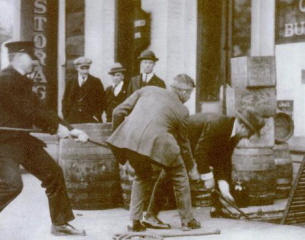The DEA has announced another massive anti-drug operation, this one involving thousands of agents, hundreds of law enforcement agencies, thousands of arrestees, millions of dollars and tons of drugs. In law enforcement terms, it's big. But it's tiny compared with the scale of drug use and the drug trade in the US, and it won't reduce the use or availability of drugs in the US.
Fire bombs. Graffiti attacks. Anonymous anti-medical marijuana flyers handed out to school children. Whether medical marijuana has gone too far is a hot issue in Billings, Montana, and it's simmering all over Big Sky Country as "ganja-preneurs" push the envelope.
There has been a dramatic increase in methadone overdose deaths in Pennsylvania and the nation in recent years. Keystone State legislators are misguidedly aiming at the state's methadone maintenance treatment clinics.
Ciudad Juarez passed a grim milestone this week as it marked its one thousandth prohibition-related killing of the year.
It was judgment day for two crooked cops and a jail guard this week, and another jail guard just found out his judgment day is coming. Meanwhile, new corrupt cop cases showed up at a rate of one a day this week.
The now infamous SWAT raid in Columbia, Missouri, in February that left a family traumatized and a family dog dead keeps on generating citizen activism there. Now, a new group formed because of the raid is calling for permanent reforms.
Canadian "Prince of Pot" Marc Emery has already run up against US federal prison rules, and is sitting in solitary confinement as a result.
The Washington state marijuana legalization initiative campaign took a serious hit this week when a union it had been courting decided not to help fund signature-gathering. Now, with only three weeks left, Sensible Washington has less than half the signatures it needs and no money. Can a heroic volunteer effort save it?
In 2006, the Michigan Supreme Court ruled that people could be prosecuted as drugged drivers based solely on the presence of marijuana metabolites in their bodily fluids. Now, a more liberal Supreme Court has overturned that decision, holding that marijuana metabolites are not controlled substances and the states drugged driving law can thus not be applied to them.
The UN says Rwanda needs a drug law. Rwanda agrees, and it's going to include medical marijuana.
Iranian hangmen have been keeping busy in recent weeks as some 30 drug offenders have been executed since May 23. Maybe it's time to ramp up that campaign against the death penalty for drug offenses.
Events and quotes of note from this week's drug policy events of years past.
2010 is a critical year in the effort to end prohibition and the war on drugs. The StoptheDrugWar.org (DRCNet) "Changing Minds, Changing Laws, Changing Lives" campaign is asking for you to pitch in -- your support is more important now than it has ever been before!
A coalition of organizations -- StoptheDrugWar.org is a partner in it -- is presenting the first full-day conference on drug policy reform on Capitol Hill. And it's free.
"This Week's Dumbest Drug War Quote," "Police Department Teaches Citizens How to Flex Their Rights," "High School Censors Marijuana Legalization Editorial in School Newspaper," "Everyone Loves to Read About Marijuana Legalization," "Marc Emery Calls Out Selfish Marijuana Growers for Opposing Legalization."
Do you read Drug War Chronicle? If so, we need your feedback to evaluate our work and make the case for Drug War Chronicle to funders. We need donations too.
Apply for an internship at DRCNet and you could spend a semester fighting the good fight!
David Borden, Executive Director

David Borden
DEA acting chief Michele Leonhart, and her boss, US Attorney General Eric Holder, are bragging about a major, DEA-led operation that has netted 2,200+ arrests, with pounds of drugs and millions of dollars seized. "
Project Deliverance" involved more than 300 law enforcement agencies, more than 3,000 DEA agents, and took 22 months. According to DEA's press release, they captured 1,262 pounds of methamphetamine, 2.5 tons of cocaine, 1,410 pounds of heroin, and 69 tons of marijuana, plus $154 million.
Operationally, Deliverance was certainly a big project -- it's easy to see why they're excited. And for the thousands of people throughout the US who were arrested in it, it's a life-changing event, though for the worse. But will Project Deliverance make any real difference in drug use and the drug trade? Is the operation really a big deal, when examined next to the reality of drug use and the drug trade in the United States today?
I hate to be a wet blanket, but if history is a guide, Project Deliverance will have no long-term impact on the drug trade. Though notable in its scale, the operation is only one of many carried out by the US and allied governments over decades. During that time, the measure of drug availability -- price, an increase implies a product is less available, relative to its demand* -- has gone in the opposite of the intended direction, and dramatically. For example, the average US street price of cocaine is less than a fifth in real terms than it was in 1980. Previous drug sweeps have seen their temporary gains erased in just one or two weeks.
The reason is that the big sounding numbers touted by Leonhart, while large for the agency and our government, are small compared with the drug trade and its incentives. Deliverance's 2.5 tons of cocaine constitute less than one percent of the 300 metric tons of cocaine the government estimates are consumed annually in the US. So do the 69 tons of marijuana. They did get a few percent of the heroin, if numbers don't deceive, but even that's still small. And the 2,200 alleged dealers and traffickers arrested in Project Deliverance make up a similarly tiny fraction of the hundreds of thousands of people employed in the US by the illegal drug trade. Some drug businesses will doubtless be extinguished by Project Deliverance, but others will have little difficulty replacing the lost supply or filling the open positions. And how much powder or weed did the investigators let go by during the 22 months it took to complete the operation? How much will they have to let slip by during the months or years it takes to mount the next one?

Michele Leonhart announcing ''Project Deliverance''
In an uncharacteristically "big picture" review published a few weeks ago, the
Associated Press declared the 40-year drug war a failure by every measure. Will media follow that lead and go beyond the surface in their reporting on Project Deliverance? I have a few suggestions for those intrepid reporters who would like to:
- Ask DEA or DOJ spokespersons if they expect the substances targeted in the sweep to be less available to US consumers of them, and if so for how long.
- Ask them if previous operations, individually or collectively, have had that effect. If they say yes, ask them to be specific as to how, and compare their evidence with numbers like the aforementioned cocaine prices.
- Do some follow-up, say two or three weeks from now. Ask government officials, cops who walk the drug beat, and drug users, what if any difference they saw in the supply of the targeted drugs after the sweep, and if so if they see still any. Follow up again in one or two months. See if DEA will give you early access to the price data.
Be forewarned that DEA reps will probably be less excited to address those questions than they were for the press conference. But the questions are no less important. Because the shiny piles of cash and drug bags whose photos you can find on the DEA web site are not the only reality of drug prohibition, nor its most important aspect. The bigger reality is that of countless drug transactions, almost entirely hidden from view, about as many of them today as there were yesterday before Project Deliverance delivered its thin slice of the drug trade, barely scratching the surface.
* Nitpickers and drug war defenders may point out that demand for cocaine has also dropped since 1980, and that the price drop could be explained that way. No dice -- frequent, "hardcore" cocaine and other drug use remained roughly constant despite a drop in the number of "casual" users, and it's the frequent users who account for the vast majority of the consumption.
back to top
With the number of medical marijuana patients expanding dramatically in the Big Sky State, with storefront operations springing up around the state, and with at least one group of medical marijuana advocates/entrepreneurs touring the state in a medical marijuana caravan complete with pot smoke-filled vans and doctors issuing instant recommendations via web cam, opposition to the way Montana's medical marijuana law is playing out is on the increase.

sign of the times
In 2004, 62% of Montana voters approved a medical marijuana ballot initiative. The number of registered patients and caregivers remained relatively low until last year, when the Obama administration announced that it would not prosecute medical marijuana users and providers in states where it is legal. At the beginning of last year, the number of registered medical marijuana cardholders was about 3,000. Now it is closing in on 15,000. And alongside the increase in registered patients has been a boom in "dispensaries," or caregiver storefront operations.
While growing concern is evident across the state, it has burned red hot in Billings, a city of about 100,000 people on I-90 in southeastern Montana, where Western conservatism is strong. There, things have turned ugly, with fire bomb attacks on two medical marijuana businesses a month ago as the city council approved a moratorium on new medical marijuana business licenses. Accompanying those attacks was graffiti painted across windows: "Not in our town," it said.
"That fire bombing was just terrorism," said Mike Meno, communications director for the Marijuana Policy Project, which bankrolled the 2004 initiative. "There is no other word for it. Local activists are telling us that people opposed to medical marijuana think it is something you can still dispute, that it's not even legal. This kind of thing is leading both sides to sort of step back and try to pass some strong regulations so people understand these are law-abiding operations."
And just last week, a group calling itself Safe Communities, Safe Kids emerged in a controversial fashion as children coming home from the last day of school in some Billings schools carried with them flyers containing its anti-medical marijuana message -- although not its name. The school board said it shouldn't have happened.
Now, Safe Communities, Safe Kids is engaged in a quixotic quest to place an initiative to repeal the Montana Medical Marijuana Act on the November ballot. Success is extremely unlikely -- the group now has one week to collect 24,000 signatures -- but the effort highlights the deep antipathy developing toward medical marijuana in various quarters of the state.
The legislature is one of those quarters, and lawmakers are busily drafting a variety of measures aimed at reining in what they view as a medical marijuana program out of control. Yesterday, Gov. Bryan Schweitzer (D) told reporters he agreed that the program needed "a legislative fix" and that he was open to working with legislators in the new session later this year.
Mark Higgins operates Montannabis Inc. and Billings Medical Marijuana, which he is careful to point out is not a dispensary, although it serves more than 200 patients, making it likely the largest caregiver in Billings. "Dispensaries are illegal under Montana law, so we are more of a private club or storefront," he explained. "We can only sell to people who designate us as their caregivers and have our name on the back of their registration card."
"It's gotten pretty insane," Higgins said of the fire bombings, but he didn't attribute them to especially nefarious forces. "I saw video of it; it was young kids with long, black hair. Kids don't think; they push it to extremes and don't think about the consequences."
Higgins is the only caregiver sitting on the city council's ad hoc committee on medical marijuana, and he ran for city council last year after the council ignored his efforts to get zoning requirements for medical marijuana storefronts. Things were getting out of hand, he said.
"The reason for the fire bombings and the parents and the initiative is that some people put marijuana storefronts close to schools, I mean really close," he said. "Who are these people trying to attract? Why would they go to locations like that? That upset a lot of people."
While the location and brazenness of some Billings operations may have inflamed what Higgins called "the West side Christian women," pushing the limits of what the law allows has caused concern and anger statewide. The above-mentioned "caravan" in particular has gotten under people's skin.
"The biggest thing is that for about a year now, a group that calls itself the Montana Caregivers Network has been going around the state holding clinics in different towns in which they have gotten physicians' recommendations for as many as a thousand patients in a single day," said Tom Daubert, who has the point man for the successful 2004 medical marijuana initiative. "They're doing it with physicians on web cams in other states, advertising no medical records necessary. They are very visible, and the guy running the group smokes pot openly. They had dozens of caregivers with big buckets of weed, and they sometimes sell to people who aren't registered. It's hellacious, it's irresponsible, and it's ridiculously stupid politically. It has incited a lot of the backlash."
Drug War Chronicle attempted to contact the Montana Caregivers Network, but the phone number listed on its web site is not a working number and the group has yet to respond to email inquiries.
"There are also a handful of folks who have created dispensaries that are similarly ridiculous in image," Daubert continued. "There are people with no business experience, sometimes with non-drug felony records opening dispensaries near schools, putting flowering plants on the porch, and just generally pushing the margins. And just as pseudo-activist ganja-preneurial craziness has taken on a life of its own, so has the backlash."
"The law needs to be fixed," said Daubert. "Even the folks who advocated for it and helped write it, we're in agreement with law enforcement on what needs to be done."
While Daubert agreed with the governor, law enforcement, and members of the legislature on the need for a legislative fix, Higgins didn't. While there is a need to suitably regulate medical marijuana storefronts, that should be a municipal issue, said Higgins, arguing that the Montana Medical Marijuana Act is working. "I think our system is fine," he said. "It's not broken and doesn't need to be fixed. All you have to do is follow the letter of the law. That's what I do."
But not everyone follows his example, he said. "There are people more willing to operate in grey areas, and there are a lot of caregiver to caregiver transfers and people who grow as wholesalers. That's not legal unless all those storefronts are their patients," Higgins explained. "The only people we can buy from are our patients. If I have a patient growing his own six plants, he can only possess one ounce of dried usable medicine, so as soon as he harvests, he's over the limit. As his caregiver, I can buy an ounce back from him. That's what we do."
A legislative interim committee is in the process of discovering how much consensus there is for legislation on the issue, Daubert said. A full Health Committee meeting is set for June 28 to discuss various proposals, and if there is consensus, committee staff could spend the summer drafting a bill for the committee to review in the fall.
For Daubert, Colorado is a model for how to regulate medical marijuana. "Why not do what Colorado has just done?" he asked. "At a minimum, I see two main thrusts: One would be tightening up the doctor recommendations to require a physical exam and diagnosis and/or a review of medical records. The doctor will have to be physically present in Montana. And it's likely there will be language prohibiting any kind of financial connection between doctors and caregivers," he said.
"The other thrust will be toward much more oversight and record-keeping and auditing and inspection of licensed products," Daubert said. "I'm advocating for recordkeeping that documents a closed-loop system, so we can document there is no diversion rather than arguing about it. Thanks to people being crazy and doing things like smoking openly, there is this mythology that there is a lot of diversion going on. This would address that."
If the legislature is going to act, said Higgins, there are some issues of patient-friendliness it should address. "If I wanted to expand my business and service the whole state, there is no way I could physically do that, so I would have to hire couriers," explained. "But there is nothing in Montana law that says that's legal. Also, they need to clarify on edibles. I don't provide them to my patients because it's a grey area," he said. "But we do give them recipes."
But from the look of it, helping the medical marijuana business thrive doesn't look to be high on lawmakers' agenda. The medical marijuana community is going to have to organize and fight to protect its interests, and if it can't find a way to police itself, lawmakers are going to be only too happy to take on the task.
"It's a shame," said Daubert. "We've been working on a careful strategy to use medical to get toward legalization. It was working until medical blew up in our faces."
back to top
Late last month, Pennsylvania state Senate Republicans -- and one Senate Democrat -- held a press conference at the statehouse in Harrisburg to roll out their "Methadone Accountability Package." The package, they said, aims at increasing safety and fiscal accountability and reducing the illicit use of methadone and methadone overdose deaths. A related Senate resolution is also calling for a moratorium on new methadone treatment centers. But methadone treatment advocates and researchers are cautioning that the package may be unnecessary, and are calling for any legislation on methadone to be based on facts and scientific evidence -- rather than overheated rhetoric and anecdotes.
Drug overdoses have risen nationally in recent years, with the increase generally being attributed to increased use of prescription medications such as methadone and buprenorphine. Advocates have suggested overdose prevention approaches such as "Good Samaritan" policies protecting people who call for help -- Washington state's legislature enacted one this week -- or distribution of the overdose antidote naloxone, as ways of stemming the tide. But the PA package announced this week goes a different direction.

the dark side: legislators seeking dramatic methadone restrictions
While the bundle of bills addresses keeping track of methadone-related deaths (SB 1293), diversion control (SB 1376), driving while using methadone (SB 1377, SB 1378), and micromanaging methadone maintenance treatment (SB 1382, SB 1383), the bill that strikes most directly at methadone maintenance treatment for opiate-dependent individuals, is
SB 1294, the Methadone Addiction Prevention and Treatment Act, introduced by Sen. Mike Stack (D-District 5). Stack's bill would mandate that:
- Potential patients be addicted to opiates for at least one year before methadone treatment is considered;
- Potential patients must have twice failed other forms of treatment;
- Patients have a written plan with goals and dates to be free from drug dependence, including methadone, within two to three years;
- Patients must have a designated driver come with them to the clinic for the first two weeks of treatment; and
- Driving under the influence of more than the prescribed dose of methadone be a violation of state driving under the influence laws.
"Pennsylvania needs better laws to prevent methadone abuse and provide patients with the proper protections and treatment plans they need to achieve a lifetime of sobriety," Sen. Stack said. "This package of bills is a solid step toward achieving those goals."
"Pennsylvania's law has not kept pace with the changes in the prescription of methadone -- and too frequently with deadly consequences," said Sen. John Eichelberger (R-District 30). "Methadone is a drug with its own unique properties. One pill or one dose can kill a non- or low-opiate-tolerant person. Even a day or two after the drug is taken, it has led to fatalities for those who mix alcohol or other drugs."
The senators cited reports from the National Drug Intelligence Center that unlawful diversion of methadone had more than doubled between 2003 and 2007 and from the National Center for Health Statistics that the number of methadone overdose deaths had increased nearly five-fold, with OD deaths among young people (15-24) increasing eleven-fold.
Not so fast, say experts. "Let's be careful about this; there are a lot of lives at stake here," said Eric Hulsey, director of performance, evaluation, and program development at the Institute for Research, Education, and Training in Addictions in Pittsburgh. "If the intention behind this stuff is better clinical care, that's a great thing, but we have to caution that it needs to be grounded on evidence-based practice."
Hulsey and National Association for Medication Assisted Recovery president Roxanne Baker also questioned some of the specifics in SB 1294. For Baker, the objections are a bill-killer.
"I would have to oppose this bill because it's too restrictive," she said. "There are already state and federal regulations on methadone treatment centers. Medicine is best left to doctors, not legislators."
Baker objected to the bill's provision for pushing methadone maintenance patients to get off the drug. "They really push the methadone abstinence schedule, don't they," she said. "Here in California, they just say it would be 'harmful to the patient' to taper off. I don't know why that needs to be in there; they don't make you taper off thyroid medication or insulin."
Hulsey didn't see a lot of evidence that methadone maintenance clinics are behind the problems being cited by the politicians. "Methadone prescribing has gone up seven-fold around the country, and we've seen all these methadone overdoses. Most of the federal reports and researchers have concluded that this is coming from the pain management clinics, yet everyone wants to crack down on the methadone treatment clinics."
Methadone treatment clinics are operated under different and stricter sets of regulations than pain clinics, Hulsey said. "It's unclear what the pain clinics are doing to prevent adverse incidents at their facilities, but it is clear that most diverted meds are coming from pain management, therefore, let's legislate against methadone maintenance clinics?"
Not that cracking down on pain clinics is the answer either, according to NAMA's Baker. Pointing out that methadone maintenance clinics are not the problem is fine, she said, but let's not be too quick to go after pain doctors. Citing the massive under-treatment of chronic pain in this country and her own decades-long experience with methadone in both the treatment and the pain clinic milieus, she said methadone patients already face enough barriers.
"I've been taking methadone since 1974," she said. "I stood in those methadone treatment lines, but now I get my medication from a pain specialist. A lot of people want to do that because they treat you better -- if you can find one who will treat you at all."
And that is a problem, Baker said. "A lot of doctors don't want to treat pain patients because they have the DEA breathing down their necks. We don't need more obstacles."
"This is misdirected legislation," said Mark Parrino, president of the American Association for the Treatment of Opioid Dependence. "Methadone treatment programs have been functioning for more than 40 years with a considerable degree of safety. There have been at least four federal studies showing that increasing methadone mortality is based on that fact that it is increasingly being used in pain management. If the legislation doesn't address the cause of the problem, it has no basis for existing."
"The science doesn't support a hard and fast rule to get off licit opiates," said Hulsey. "It can be very dangerous to put arbitrary deadlines on that. Treatment has to be individualized to promote recovery."
For Hulsey, the bill's requirement that potential patients first twice fail at treatment is just not good policy. "I am not aware of science that supports 'you fail first' policies," he said. "If you go to the expert consensus guidelines for management of methadone facilities, and more importantly, accepted patient placement criteria, you must demonstrate a year's dependency, as well as other thresholds, and that is what should determine appropriate placement. 'Fail first' doesn't capture the full range of factors that experts have agreed upon as the best approach for opiate-dependent individuals."
The consensus guidelines Hulsey cited were SAMSHA/CSAT's Treatment Improvement Protocol 43 and the American Society of Addiction Medicine's Patient Placement Criteria.
"Those are the gold standard for treatment," he said. "They provide a six-dimensional approach to dependence, and you would need to meet those criteria to be appropriately placed in methadone maintenance. It's not appropriate for everybody. Some people may require a detox approach rather than long-term maintenance."
For Hulsey, having the designated driver requirement for new patients was "good risk management," but creating methadone-impaired driving offenses seemed unnecessary. "There are already laws on the books regarding impairment," he said.
Nobody thought the moratorium on new methadone maintenance clinics was a smart move. "They shouldn't do that," said NAMA's Baker. "They don't put moratoriums on doctors who prescribe treatments for diabetics. But there is a lot of NIMBYism in Pennsylvania."
"Addiction is a chronic disease that is treatable when appropriate evidence-based treatment approaches are applied," said Hulsey. "We want to promote recovery and support people rather than limiting access. If we limit the treatment opportunities, we make these people criminals."
Parrino didn't think much of the moratorium idea, either. "You can have a moratorium, but that doesn't reduce the demand for treatment, so what's the rationale for restricting access to care? Do we think the number of people who need this has capped out? That state has to be careful saying that a moratorium seems smart, especially when the problem is not related to the treatment programs you're dealing with," he said.
But methadone maintenance clinics make convenient targets for a number of reasons, said Parrino. "There is NIMBYism, and there is a general stigma about treating addiction, which increases markedly when you talk about the use of medications to treat opiate addiction," he pointed out.
"And elected officials always feel like 'we must do something,'" he continued. "But unless the legislature is able to be more precise in identifying the problem and how to deal with it, I would suggest that they are not addressing the real source of the problem, but doing what seems manageable and convenient. It's easy to say let's put more restrictions on top of a system that is already highly regulated, but pain doctors aren't regulated at all."
So faced with mounting methadone mortality and increasing diversion not linked to methadone maintenance clinics, Pennsylvania legislators are aiming squarely at those clinics. The legislature and the people of Pennsylvania would be better served if this package of bills went back to the drawing board.
back to top
by Bernd Debussman, Jr.
Mexican drug trafficking organizations make billions each year smuggling drugs into the United States, profiting enormously from the prohibitionist drug policies of the US government. Since Mexican president Felipe Calderon took office in December 2006 and called the armed forces into the fight against the so-called cartels, prohibition-related violence has killed an estimated 23,000 people, with a death toll of nearly 8,000 in 2009 and over 4,000 so far in 2010. The increasing militarization of the drug war and the arrest of dozens of high-profile drug traffickers have failed to stem the flow of drugs -- or the violence -- whatsoever. The Merida initiative, which provides $1.4 billion over three years for the US to assist the Mexican government with training, equipment and intelligence, has so far failed to make a difference. Here are a few of the latest developments in Mexico's drug war:
Sunday, May 29
In Morelos, the body of a prison warden was found dismembered and scattered across several locations. Suspected cartel gunmen kidnapped Luis Navarro the previous day as he arrived to work. Morelos State has seen a significant increase in violence in 2010 as rival factions battle for leadership positions in the Beltran-Leyva Organization, which was left leaderless after the December killing of boss Arturo Beltan-Leyva.
Tuesday, June 1
In the city of Chihuahua, two men were shot dead in front of dozens of panicked children outside a primary school. The incident began after heavily armed men exited a truck and began shooting at two men who were walking on the sidewalk. Teachers immediately had the students, all between the ages of six and twelve, lay prone on the floor. Several dozen bullets struck the schoolyard, and several struck the walls of a classroom. Classes were immediately canceled and parents were instructed to pick up their children.
In Guerrero, six people were killed during a running gun battle between groups of rival gunmen along an eleven-mile stretch of highway. In other violence, seven people were killed in Baja California, three each in Sinaloa, Sonora, Michoacan, and the State of Mexico, two in Veracruz, and one each in Nuevo Leon and Durango.
Wednesday, June 2
In Vicente Guerrero, Durango, a high-ranking police official was killed as he was in the hospital for physical therapy. The incident occurred after two gunmen snuck past his bodyguards and shot him six times, and wounding two other individuals, one of whom was a minor.
In Ciudad Juarez, a three year old girl was killed alongside her father after their car was sprayed with gunfire. In the notorious drug-trafficking town of Guanecevi, Durango, a 21-year old male who had been missing for 10 days was found dead. In Monterrey, a couple was killed in a bar by men wielding automatic weapons. In Tijuana, four people were killed in various incidents.
Saturday, June 5
In Guerrero, at least 37 bodies have so far been recovered from a mass grave discovered at an abandoned mine shaft on May 30. Due to the large number of bodies recovered so far, some have had to be sent to Acapulco due to a lack of local facilities in which to store the bodies. Although the identities of the bodies have yet to be determined, authorities believe they were all killed in drug-related violence over an unspecified amount of time. The number of bodies was later changed to 55.
In Durango, four police officers were wounded in an attack on Durango State Public Safety Secretary General Valentin Romano. The attack occurred when heavily armed gunmen used automatic weapons and grenades to attack the general's convoy as it made it's way to a country club where was planning to play tennis. The attack was well planned, with gunmen opening fire in at least three other locations across the city to draw security forces away from the area where it took place.
Sunday, June 6
In Guerrero, three people were killed when gunmen raided a girl's 15th birthday party. One of those who died was an attacker who was killed after an exchange of gunfire with armed men who were in attendance at the party.
Monday, June 7
In Ciudad Juarez, 15 people were killed across the city. In one incident, four people were shot dead in an auto shop. In another, two people were gunned down in a shopping center. Two people were found out the Seven and Seven bar in the Cuernavaca neighborhood. The Seven and Seven was the scene of another multiple homicide several months agoi. These killings bring the number of murders in Ciudad Juarez to 50 for the month of June, and 1,130 for 2010.
Tuesday, June 8
In Culiacan, Sinaloa, six prison inmates were killed after having their throats cut. Culiacan has long been a central location in the Mexican drug trade. Additionally, another prison fight in Ciudad Juarez left three inmates dead and a federal police officer severely beaten.
Wednesday, June 9
In Mexico City, 45 pounds of explosive were seized by Mexico's Navy after a raid in the Roma neighborhood of the city. Federal authorities have recently stated that they believe drug cartels are in search of explosive materials for attacks on buildings are for use in roadside bombs. The hostel were the raid took place is just blocks away from a 2008 bomb incident, in which a would-be bomber was killed in an attempt to attack a local police station. The plot was later traced to Sinaloa-based drug traffickers.
In Manzanillo, Colima, eight gunmen were killed and five Marines were wounded after a Marine patrol was ambushed just outside the city. At least one of those killed was a woman, and another was found to be a Colombian national. Preliminary reports the attackers were affiliated with the Beltran-Leyva organization.
Total Body Count for the last two weeks: 437
Total Body Count for the Year: 4,794
Read the last Mexico Drug War Update here.
back to top
It was judgment day for two cops and a jail guard this week, and another jail guard just found out his judgment day is coming. Meanwhile, new corrupt cop cases showed up at a rate of one a day this week. Let's get to it:
In El Paso, a US Customs and Border Protection officer was arrested Monday on federal charges of conspiracy to distribute marijuana. Officer Daniel Ledezma, 33, is accused of knowingly allowing trucks filled with marijuana to pass through the Bridge of the Americas. He was in the El Paso County Jail pending a hearing this morning.
In Los Angeles, an LAPD officer was charged Tuesday on federal methamphetamine distribution charges. Officer Yoshio Romero, 28, a five-year veteran, is accused of arranging to sell 111 grams of meth last December for $42,000. He allegedly placed the drugs in a box in a pick-up truck, then told the buyer where the truck could be found.
In Providence, Rhode Island, a fourth Providence police officer has been arrested in a massive drug sting that in March resulted in the arrest of three more Providence police officers. The fourth officer, whose name was not revealed, turned himself in Wednesday. Twenty people have been indicted so far in "Operation Deception," with two still being sought on warrants.
In McAllen, Texas, the Sullivan City police chief was indicted Thursday on federal drug and conspiracy charges as part of the massive "Project Deliverance" sweep that netted more than 2,200 people nationwide. Police Chief Hernan Guerra had been arrested by FBI agents the day before the indictment was unsealed. He is accused of being part of a conspiracy that moved at least two tons of marijuana through the Rio Grande Valley in the last year. The chief is now on administrative leave.
In Franklin, Indiana, two Franklin police officers have been hit with a sexual harassment lawsuit from a former informant. The lawsuit claims Franklin Detective Bryan Burton made a deal with the victim to help with her DUI and child custody problems in exchange for her help busting drug dealers. She wore a wire and a concealed camera, but Burton began behaving inappropriately, the lawsuit alleges. It says he entered her home, photographed a sex toy, put it in her car when she didn't know it was there so she would sit on it. The lawsuit also claims Burton exposed himself to her and that his partner, Officer Ryan Mears, went along with it. Burton was already in trouble this year, having been demoted in March for drinking on duty, providing alcohol to minors, and making suggestive remarks to female informants.

DRUGS INSIDE: Baltimore City Detention Center
In Craig, Colorado,
a former Craig Police detective was sentenced Tuesday in Moffat County District Court to serve 60 days in jail for his corrupt relationship with a Craig woman with past convictions for drug distribution and possession. Former detective Ken Johnson was arrested last September for providing the woman information about ongoing police investigations and helping her break probation. He also gave her a laptop belonging to the department. He was originally charged with embezzlement of public property, and accessory to a crime -- both felonies -- as well as attempting to influence a public servant, a lesser felony. He copped to the latter in return for a plea agreement where prosecutors stipulated no more than 60 days in jail. Johnson will do all but a week on work release. He must also do 150 hours community service, pay $1700 in fines and costs, undergo psychotherapy and DNA testing, and write letters of apology to the department, the Moffat County Drug Court and the All Crimes Enforcement Team of which he was a member. He starts his sentence today.
In Baltimore, a former Baltimore City Detention Center guard was sentenced Monday to two years in prison after pleading guilty to smuggling drugs and a cell phone to a prisoner there. Lynae Chapman, 21, went down last October after prison officials found her DNA on drugs and a cell phone discovered during the search of a prisoner's cell. She was convicted of six charges, including conspiracy to distribute marijuana and professional misconduct in office.
In Platte City, Missouri, a former Weston police officer was sentenced June 3 to four years in prison for stealing drugs from the department's evidence room. Kyle Zumbrunn, 27, had pleaded guilty to stealing a controlled substance. He had already pleaded guilty in Atchinson County, Kansas, to selling the dope he stole and was sentenced to 16 months there. The four-year Missouri sentence will run concurrently with the Kansas sentence. He had been looking at up to seven years in prison.
In Paterson, New Jersey, a former Passaic County Jail guard was convicted last Friday on charges he smuggled heroin and homemade weapons into the jail. Former guard Marvin Thompson was acquitted of bringing escape implements into a jail, but convicted of heroin possession and filing false police reports. Thompson went down in a bizarre effort at self-aggrandizement: He smuggled the contraband into the jail with plans to then "discover" it and blame it on a gang leader in a bid to earn a permanent position, but an inmate snitched him out, and instead of a permanent job at the Passaic County Jail, he is now a temporary resident of a nearby county jail awaiting a probable transfer to the state pen. He faces five to 10 years in prison when he is sentenced July 9.
back to top
The February SWAT team raid on Columbia, Missouri, resident Jonathan Whitworth and his family didn't start causing political tremors until video of the raid, in which one of the family's dogs was killed and another wounded, went viral on YouTube last month. But now, even after the Columbia Police Department has reined in SWAT with new policies, outrage and concern over the raid and the way the SWAT team has been used continues to reverberate.
That was evident at a city council meeting Monday night, where a citizens' group whose formation was inspired by the SWAT raid,
CoMoCitizens, urged the council to go a step further and act to make permanent the reforms announced by Police Chief Ken Burton. According to its web site, the group opposes the use of SWAT and the use of search warrants in nonviolent cases, including drug possession and distribution.
"It goes without saying that it is policy that needs to be changed," Warren said in remarks reported by the University of Missouri newspaper The Maneater and the Columbia Missourian. "Chief Burton has made significant policy changes and I've come here to ask you to make these policy changes permanent. I would also like to request that you consider enacting a policy that prohibits execution of search warrants which are inherently violent for nonviolent offenses," said Warren. "This would ensure the public that there is at least less of a risk of an incident such as the February 11 SWAT raid occurring in our community."
Making the restrictions on SWAT and the execution of search warrants binding would reassure the public and keep law enforcement officers safer, Warren said. "The raid itself is what escalates the situation to out-of-control mode," he told the council before reading from Radley Balko's Overkill: The Rise of Paramilitary Policing in America. "These raids bring unnecessary violence and provocation to nonviolent drug offenders, many of whom were guilty of only misdemeanors," Warren quoted Balko.
The council did not act on CoMoCitizens' requests, but the emergence of the group is yet another indicator that the February SWAT raid has roused Columbia's citizenry. And that is precisely what it will take to make police law enforcement rein in its aggressive tactics against the citizenry. Maybe something good is coming out of that misbegotten raid after all.
back to top
Canadian "Prince of Pot" Marc Emery hasn't even been formally sentenced yet, but he's already being punished for what he does best: opening his mouth for the cause of marijuana legalization. Emery's wife, Jodie, told Canada's CNews Saturday that Emery is now in solitary confinement for violating prison rules.

Marc Emery
According to Jodie Emery, she recorded his calls from prison and played them as a podcast on the couple's
Cannabis Culture magazine web site. That violated a prison rule that phone calls can only be made between a prisoner and the intended recipient and cannot be directed to a third party.
Jodie Emery said Marc had read the prison rules and did not think the podcast would be a violation. Now he will spend at least a week in solitary pending a hearing to determine the full extent of his punishment.
Emery, Canada's most famous legalization activist, pleaded guilty May 24 to one count of conspiracy to manufacture marijuana, the culmination of a five-year battle between Emery and Canadian and US authorities to extradite and prosecute him for selling pot seeds over the Internet. Two of Emery's employees arrested along with him, Greg Williams and Michelle Rainey, earlier copped pleas and received probationary sentences to be served in Canada.
Emery plowed the profits from his business back into the legalization movement, earning the wrath of the drug prohibition establishment in both countries. When Emery was busted in 2005, then DEA administrator Karen Tandy gloated in a press release that it was "a significant blow not only to the marijuana trafficking trade in the US and Canada, but also to the marijuana legalization movement."
Under federal prison rules, Emery is allowed 300 minutes of phone calls a month and he can communicate via email through a closed computer system called CorrLinks, under which he can log onto a computer and compose a message that is read by prison officials before they send it over the Internet. Emery had used CorrLinks to post numerous dispatches from the gulag, but now, he is denied those privileges and could lose them for up to two months.
Emery will remain in the Seattle-area federal detention facility until his formal sentencing September 10. Then he will be transferred to the federal prison at El Reno, Oklahoma, where prison officials will decide where he will be sent to serve his time.
Emery's campaign to avoid extradition has now shifted to a campaign to persuade Canadian authorities to allow him to serve his sentence there, as has typically been the case with Canadians convicted of offenses in the US. But the Conservative government has in recent years begun to refuse to accept Canadians imprisoned on drug charges in the US.
back to top
After a weeks-long courtship with the Service Employees International Union (SEIU) failed to be consummated with cash, organizers of the Washington state marijuana legalization initiative, I-1068 are, on one hand, vowing to fight on, and on the other, suggesting the effort could be called off soon for lack of funds.

Seattle Hempfest, 2009
campaign chairman Doug Hiatt told the
Associated Press Monday that the group had gathered 100,000 signatures to get the initiative on the ballot, but they need 241,000 valid signatures by July 2 to make the ballot. The group had been counting on the SEIU to help with paid signature gathering, but on Monday, the SEIU said it had decided not to support the effort.
Adam Glickman, vice president of SEIU Local 775, told the AP the union had contributed $10,000 to the campaign for polling and signature vetting and that research had suggested having the initiative on the November ballot could increase liberal turnout in the fall. But Sensible Washington's lack of financial resources raised questions about whether it could in fact get out the vote come November.
He also cited the ACLU of Washington's opposition to the initiative. The ACLU opposes the initiative because, it says, it does not provide a regulatory framework. The ACLU is correct -- the initiative simply removes marijuana offenses from the criminal code -- but Sensible Washington argues that if the initiative were to pass, the legislature and local authorities would be quick to act to set up a regulatory regime.
"There's some merit in the campaign," Glickman said. "It seemed worth looking at as a good policy proposal. But as we looked more into it, there were too many questions about the policy, too much division among the stakeholders. We concluded it wasn't the right time to get involved."
"It's really unfortunate, but you cannot do this without money," Hiatt said of the SEIU's decision. "I never intended I-1068 to be an all-volunteer effort. We'll make a decision in a couple days about whether we're going to go forward."
Campaign spokesman and initiative coauthor Philip Dawdy was less fatalistic. "Politics in this state stinks," he said in a press release Monday. "Marijuana smells better. It's disappointing that SEIU and others have walked away from us, but this campaign will fight on because the issue is simply too important."
"If we get some more volunteers, we can legalize marijuana in Washington State," added Jeffrey Steinborn, an initiative coauthor and Seattle-based attorney who has defended marijuana users for three decades.
The group said it has 20,000 petitions in circulation -- enough for 400,000 signatures -- and is urging activists to send them in sooner rather than later. But now, it's beginning to look like Sensible Washington's uphill battle just got a lot steeper.
back to top
The Michigan Supreme Court Tuesday ruled that it is not illegal to drive while having marijuana metabolites in the body, reversing a 2006 decision by a more conservative version of the court. Marijuana metabolites are not a controlled substance under state law, and their mere presence thus cannot be the basis of a conviction under the state's drugged driving law, the court held.
The ruling came in
People v. Feezel, in which the court overturned the conviction of a driver in the death of a severely drunk pedestrian walking in the middle of a five-lane road at night. The driver, George Feezel, was himself borderline intoxicated on alcohol, blowing a 0.009, and also tested positive for marijuana metabolites, which can linger in the system for days or weeks after the pot high is gone. Feezle was found not guilty of drunk driving causing a death, but convicted of second-offense drunk driving (a misdemeanor in Michigan), leaving the scene of a fatal accident, and driving under the influence of marijuana -- although there was no testimony to the effect that he had used marijuana that evening and there was testimony to the contrary.
The court ruled that a Washtenaw County jury should have been allowed to hear evidence the victim was drunk, remanding the case back to circuit court. But in ruling that marijuana metabolites are not a controlled substance, the court invalidated what was in effect a per se zero tolerance drugged driving law that allowed for people to be convicted of driving while impaired when they were not actually shown to be impaired.
"We hold that 11-carboxy-THC is not a schedule 1 controlled substance under MCL 333.7212 [controlled substances act] and, therefore, a person cannot be prosecuted under MCL 257.625(8) [drugged driving act] for operating a motor vehicle with any amount of 11-carboxy-THC in his or her system," read the opinion.
The opinion, largely a demolition of the previous Supreme Court's 2006 ruling in People v. Derror that marijuana metabolites are a controlled substance, thus allowing for drugged driving convictions based solely on their presence, noted that Michigan is now a medical marijuana state and that allowing Derror to stand would unfairly impact medical marijuana patients.
Under Derror, Justice Corrigan wrote for the majority, "Individuals who use marijuana for medicinal purposes will be prohibited from driving long after the person is no longer impaired. Indeed, in this case, experts testified that, on average, the metabolite could remain in a person's blood for 18 hours and in a person's urine for up to 4 weeks."
It's not just about medical marijuana patients, the opinion suggested: "Thus, under Derror, an individual who only has 11-carboxy-THC in his or her system is prohibited from driving and, at the whim of police and prosecutors, can be criminally responsible for choosing to do so even if the person has a minuscule amount of the substance in his or her system. Therefore, the Derror majority's interpretation of the statute defies practicable workability given its tremendous potential for arbitrary and discriminatory enforcement."
It is neither fair nor just nor in the interest of public safety to charge people with drugged driving who aren't impaired. Finally, there is a Michigan Supreme Court that recognizes this.
back to top
The Rwandan Ministry of Health has sent to Parliament a bill that would legalize the use of marijuana and other drugs for medical purposes, the Rwandan newspaper New Times reported Wednesday. Health Minister Dr. Richard Sezibera, who presented the draft law governing drugs, psychotropic substances, and precursors, said the bill would protect the population.

Richard
"The objective of this bill is to contribute to the protection of the population while ensuring that drugs and psychotropic substances are exclusively available for scientific and medical purposes,"
Sezibera told the Parliament.
The bill complies with United Nations conventions on drugs and responds to the UN's call for every country to have laws against illegal drugs and to control dangerous medications, said Sezibera. At the same time, it achieves the Health Ministry's mandate to ensure that citizens have adequate access to medications, he said.
"Medically, usage of such substances help in relieving the pain and problems related to psychic troubles," said Sezibera. "The medicine will thus be available and correctly utilized."
Members of Parliament endorsed the bill without objection, New Times reported.
back to top
Just three weeks ago, we did a feature article on the International Harm Reduction Association report, The Death Penalty for Death Offenses: Global Overview 2010 and the associated international campaign against the death penalty through the Harm Reduction and Human Rights campaign known as HR2. Since then, Iran has been on an execution binge, proving the report's contention that it is one of the world's most egregious offenders and highlighting the need for the anti-death penalty campaign to continue and intensify.

International Anti-Drugs Day drug burn, Tehran, Iran
According to the anti-death penalty group
Hands Off Cain, which compiles information about death sentences and executions from local sources, Iranian hangmen have been very busy with drug offenders indeed lately.
On May 23, two days after our article came out, a man identified only as "SR" was hanged in Khuzestan's Karoun Prison for carrying 675 grams of heroin. Two days later, four people identified only by their initials were hanged in Yazd Prison, three for trafficking crack, marijuana, opium, and heroin, and one for trafficking 125 kilos of opium. On May 31, Afghans in Afghanistan's western Herat province reported that seven of their relatives had been executed in Taibad prison and asked the government's help in retrieving their bodies. That same day, another Afghan citizen, Nour Jamal S., was hanged at Isfahan prison for smuggling 1,385 kilos of crack cocaine, and two more people were hanged in Shirvan Prison in Khorasan province for drug trafficking.
There was no let-up so far this month. Last Friday, Jalil B. was hanged in Mianeh Prison in East Azerbaijan for drug trafficking. On Monday, 13 people were reported hanged for drug trafficking in Ghezel Hesar Prison in Teheran. On Tuesday, a man identified only as Masoud, 33, was reported hanged in Teheran for drug trafficking.
That's 30 people executed for drug offenses in the Islamic Republic in the last three weeks. But Iran isn't the only offender, even if it's the only one that actually put someone to death for a drug offense in that time period. Death sentences for drug offenses were handed out to a methamphetamine trafficker in Malaysia, five drug offense death sentences were handed down to foreigners in the United Arab Emirates, and five Chinese nationals were sentenced to death for drug trafficking in Vietnam.
And the beat goes on...
back to top
June 17, 1971: President Nixon declares war on drugs, calling drug abuse "public enemy number one in the United States" in a press conference, announcing the creation of the Special Action Office for Drug Abuse Prevention (SAODAP), to be headed by leading methadone treatment specialist Dr. Jerome Jaffe. [Historical Note: During the Nixon era, for the only time in the history of the war on drugs, the majority of funding went toward treatment rather than law enforcement.]
June 13, 1994: The RAND Corporation releases a study finding that drug treatment programs are seven times more cost effective for reducing cocaine use than law enforcement efforts, 11 times more effective than border interdiction and 23 times more effective than source country efforts.
June 12, 1998: US drug czar Barry McCaffrey announces at the United Nations his plan for drug warriors to dominate the Internet by adding a massive number of web sites.
June 15, 1998: Random House publishes Mike Gray's masterpiece exposing the futility of the war on drugs, "Drug Crazy: How We Got Into This Mess and How We Can Get Out."
June 16, 1999: Testifying before the Criminal Justice, Drug Policy and Human Resources panel of the House Government Reform Committee, ACLU executive director Ira Glasser tells lawmakers that the most effective way to control drug abuse is through regulation, not incarceration.
June 14, 2000: Bestselling author, cancer and AIDS patient, and high profile medical marijuana activist Peter McWilliams is found dead in his home in Los Angeles, California. McWilliams, barred by a federal court order from using marijuana to counteract the extreme nausea caused by his AIDS drugs, is found choked to death on vomit, slumped on his bathroom floor. Prosecutors in the case say they are "saddened by his death."
June 11, 2001: In a case relating to indoor marijuana-growing operations, the US Supreme Court rules that the use by the police of a thermal imaging device to detect patterns of heat coming from a private home is a search that requires a warrant.
back to top

Dear friend of drug policy reform:
I am writing today to ask you to step up for drug policy reform. 2010 is a critical year in drug policy, with great opportunities for changing minds, laws, and lives:
There is a long, hard road still ahead, but things are definitely moving our way. Like every nonprofit, our funding has been affected by the troubled state of the economy, and we need your help. Can we count on your support in this important year? Please make a generous donation to StoptheDrugWar.org (DRCNet) today!
The support of our generous members has been part of a winning combination that saw us draw nearly two million annual visitors to our web site last year -- the most yet! -- and which saw opinion leaders in the blogosphere using our work on a regular basis. (See links about this below.) StoptheDrugWar.org, thanks to you, is the #1 source for news, information and activism promoting sensible drug law reform and an end to prohibition worldwide. The more we do at StoptheDrugWar.org, the faster the reform movement will grow and the sooner that minds, laws and lives will change.
Your support counts now more than ever -- please join our 2010 "Changing Minds, Changing Laws, Changing Lives" campaign by donating to StoptheDrugWar.org today.
I would like to send you some free gifts to show our appreciation. For a contribution of $30 or more, choose either the important new DVD, 10 Rules for Dealing with Police, or its classic predecessor, Busted: The Citizen's Guide to Surviving Police Encounters -- or choose either of our popular StoptheDrugWar.org t-shirts -- "alcohol prohibition/drug prohibition" or "consequences of prohibition." For a gift of $55 or more, you get to pick any two... for a gift of $80 or more, pick any three... for a gift of $100 or more you can get all four! (Want to substitute? No problem. Choose any item from our inventory of books, videos and StoptheDrugWar.org items.)
By joining today, you will make an immediate impact by helping StoptheDrugWar.org:
We are truly seeing more good things happen than ever before -- and the road ahead while challenging is also promising. Please donate to StoptheDrugWar.org today - with your help, we can win this.
Sincerely,

David Borden
Executive Director, StoptheDrugWar.org (DRCNet)
P.S. Prohibition does not work -- and more and more people know it. Now is the perfect time to galvanize support for the cause. Please send in your donation and get your thank-you gifts today! Thank you for your support.
back to top
StoptheDrugWar.org (DRCNet) is pleased to be a Partner in the free upcoming conference, "New Directions: A Public Health and Safety Approach to Drug Policy." New Directions DC will be the first-ever full day conference on drug policy reform on Capitol Hill. Join us to reframe the drug policy debate in the United States to focus on a public health, rather than a criminal justice, approach.
When asked about the war on drugs on the campaign trail President Obama said, "I believe in shifting the paradigm, shifting the model, so that we focus more on a public-health approach [to drugs]." Polls show the American people agree. But what exactly is a public health approach to drugs? By bringing together a broad spectrum of organizations to examine the four pillars of any successful drug strategy -- Prevention, Treatment, Policing, and Harm Reduction -- the one-day New Directions conference seeks to answer that question.
Conference Objectives:
- Clarifying the role of national government in determining drug policy;
- Brainstorming new approaches to difficult policy and implementation problems;
- Fostering connections among groups that have not traditionally worked together, but should;
- Developing a shared course of action to build evidence-based policies and strategies; and
- Identifying where further research is needed.
Agenda:
- 8:45-9:15 -- Registration and Breakfast
- 9:15-9:30 -- Opening and Welcoming Remarks
- 9:35-10:50 -- Panel: The War at Home
- 11:00-12:15 -- Panel: Treating Drug Use as a Health Issue
- 12:15-1:00 -- Lunch and Speaker
- 1:00-2:15 -- Panel: Reducing Crime and Incarceration
- 2:25-3:40 -- Panel: Protecting Treatment from the Criminal Justice System
- 3:45-5:00 -- Roundtable: A New Bottom Line in US Drug Policy
Partial Speaker List:
- Lynn M. Paltrow, JD, Founder and Executive Director of National Advocates for Pregnant Women
- Deborah Peterson Small, Executive Director and founder of Break the Chains
- P. David Soares, JD, Albany County District Attorney
- Kash Heed, Member of the Legislative Assembly for Vancouver-Fraserview and Minister of Public Safety and Solicitor General
- Thomas Zeltner, MD former Secretary of Health for Switzerland and Director-General of the Federal Office of Public Health (FOPH) of Switzerland
New Directions is presented by the Drug Policy Alliance, the National Association of Social Workers, the National Black Police Association, and Physicians for Human Rights, and takes place June 17, 8:30am-5:00pm, in the Rayburn House Office Building, Room B338, on Capitol Hill in Washington, DC. Please RSVP to [email protected].
back to top
Along with our weekly in-depth Chronicle reporting, DRCNet also provides daily content in the way of blogging in the Stop the Drug War Speakeasy -- huge numbers of people have been reading it recently -- as well as Latest News links (upper right-hand corner of most web pages), event listings (lower right-hand corner) and other info. Check out DRCNet every day to stay on top of the drug reform game! Check out the Speakeasy main page at http://stopthedrugwar.org/speakeasy.

prohibition-era beer raid, Washington, DC (Library of Congress)
Since last issue:
Scott Morgan writes: "This Week's Dumbest Drug War Quote," "Police Department Teaches Citizens How to Flex Their Rights," "High School Censors Marijuana Legalization Editorial in School Newspaper," "Everyone Loves to Read About Marijuana Legalization," "Marc Emery Calls Out Selfish Marijuana Growers for Opposing Legalization."
Phil Smith posts early copies of Drug War Chronicle articles.
David Guard posts numerous press releases, action alerts and other organizational announcements in the In the Trenches blog.
Again, http://stopthedrugwar.org/speakeasy is the online place to stay in the loop for the fight to stop the war on drugs. Thanks for reading, and please join us on the comment boards.
back to top
Do you read Drug War Chronicle? If so, we'd like to hear from you. DRCNet needs two things:
- We are in between newsletter grants, and that makes our need for donations more pressing. Drug War Chronicle is free to read but not to produce! Click here to make a donation by credit card or PayPal, or to print out a form to send in by mail.
- Please send quotes and reports on how you put our flow of information to work, for use in upcoming grant proposals and letters to funders or potential funders. Do you use DRCNet as a source for public speaking? For letters to the editor? Helping you talk to friends or associates about the issue? Research? For your own edification? Have you changed your mind about any aspects of drug policy since subscribing, or inspired you to get involved in the cause? Do you reprint or repost portions of our bulletins on other lists or in other newsletters? Do you have any criticisms or complaints, or suggestions? We want to hear those too. Please send your response -- one or two sentences would be fine; more is great, too -- email [email protected] or reply to a Chronicle email or use our online comment form. Please let us know if we may reprint your comments, and if so, if we may include your name or if you wish to remain anonymous. IMPORTANT: Even if you have given us this kind of feedback before, we could use your updated feedback now too -- we need to hear from you!
Again, please help us keep Drug War Chronicle alive at this important time! Click here to make a donation online, or send your check or money order to: DRCNet, P.O. Box 18402, Washington, DC 20036. Make your check payable to DRCNet Foundation to make a tax-deductible donation for Drug War Chronicle -- remember if you select one of our member premium gifts that will reduce the portion of your donation that is tax-deductible -- or make a non-deductible donation for our lobbying work -- online or check payable to Drug Reform Coordination Network, same address. We can also accept contributions of stock -- email [email protected] for the necessary info.
back to top
Want to help end the "war on drugs," while earning college credit too? Apply for a StoptheDrugWar.org (DRCNet) internship and you could come join the team and help us fight the fight!
StoptheDrugWar has a strong record of providing substantive work experience to our interns -- you won't spend the summer doing filing or running errands, you will play an integral role in one or more of our exciting programs. Options for work you can do with us include coalition outreach as part of the campaign to rein in the use of SWAT teams, to expand our work to repeal the drug provision of the Higher Education Act to encompass other bad drug laws like the similar provisions in welfare and public housing law; blogosphere/web outreach; media research and outreach; web site work (research, writing, technical); possibly other areas. If you are chosen for an internship, we will strive to match your interests and abilities to whichever area is the best fit for you.
While our internships are unpaid, we will reimburse you for metro fare, and DRCNet is a fun and rewarding place to work. To apply, please send your resume to David Guard at [email protected], and feel free to contact us at (202) 293-8340. We hope to hear from you! Check out our web site at http://stopthedrugwar.org to learn more about our organization.
back to top















